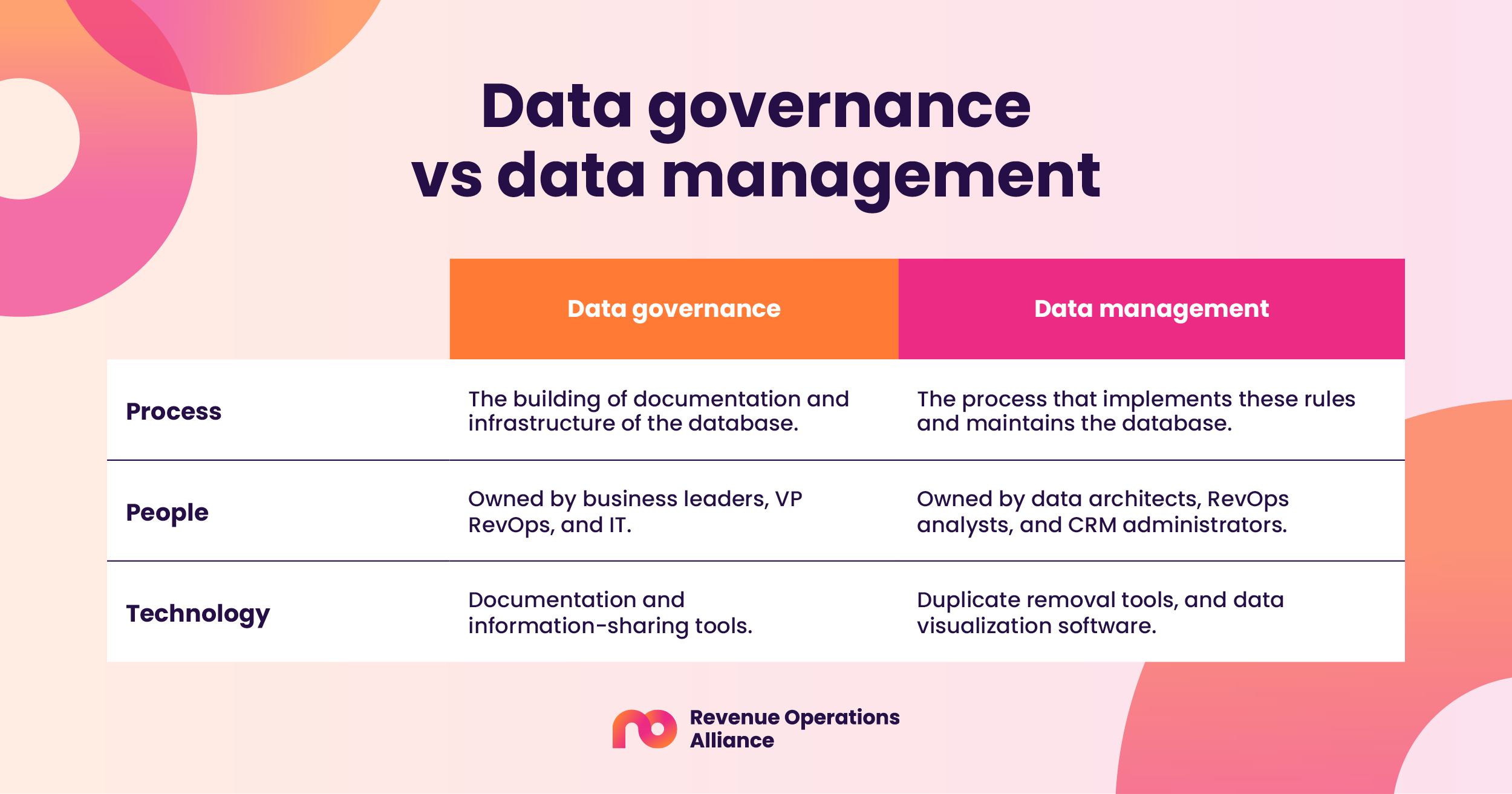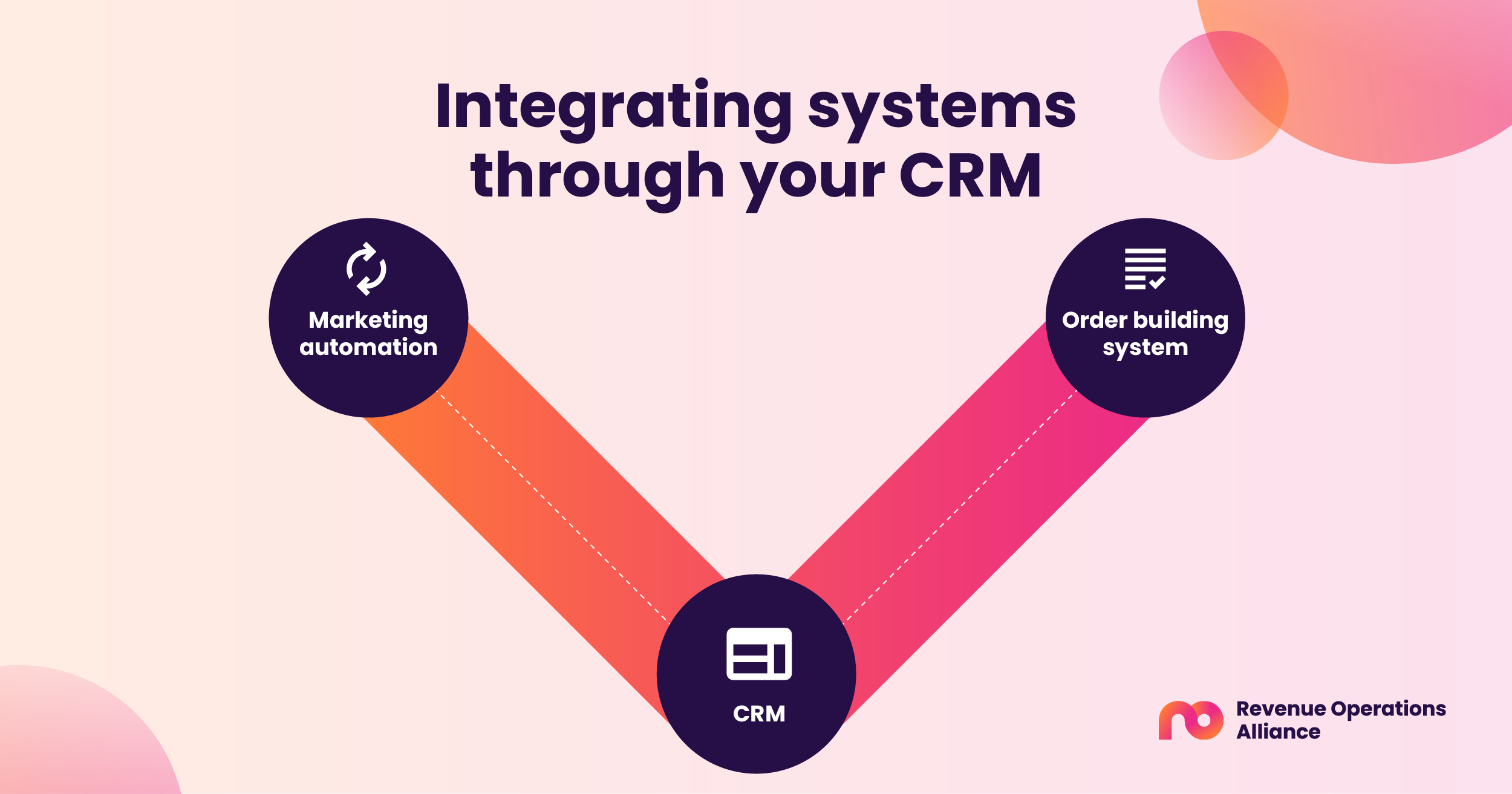Revenue operations professionals spend a lot of time maintaining the health of their organization’s CRM database. But what are the principles that determine these hygiene practices?
Database governance and database management are two key aspects of managing your data that are worth defining. This article discusses the difference between the two concepts and how you can use them to define your data hygiene process.
We cover:
- What is database governance?
- What is database management?
- What are the differences between data governance and data management?
- How can you create a single source of truth with data governance and management?
- What do the experts have to say?
What is database governance?
Database governance is a set of principles, standards, and rules that apply to the lifecycle of data within your organization. This sets the standard for maintaining a clean CRM and data integrity within your organization.
The data lifecycle includes collection, storage, use, protection, archiving, and deletion of data. Your data governance policies should guide appropriate data management at each of these stages, and detail who owns the data or process.

What is database management?
Database management is the technical implementation and execution of data governance policies. Without data management, data governance would just be a pile of documents.
Some tasks associated with database management include: cleaning, standardizing, encrypting, archiving, and deleting data.

3 key differences between data management and data governance
There are three key differences between data management and data governance: process, people, and technology. Let’s dive into each of them.
Process
In the most basic terms, data governance is the building of documentation and procedures, and data management is the process that implements these rules into the database.
Doyle Slayton, Senior Director of Sales and Revenue Operations at Jenzabar, describes the process involved in data governance as:
“Creating data definitions, ensuring that all mappings across the tech stack are in alignment, removing all duplicate fields that could mean the same thing, and building out the infrastructure for the data.”
Other processes associated with data governance include:
- Quality checking
- Defining data access policies
- Complying with regulations (eg. privacy)
- Developing and maintaining a business glossary
On the other hand, data management involves processes that maintain database hygiene such as data transformations for consistency, managing data storage systems, connecting tools to the CRM, and pulling out datasets for analysis.

People
Since the processes differ between data governance and management, it only makes sense that different team members will be involved.
Data governance tends to involve business leadership (such as a VP of RevOps, VP of Sales, CMO, etc.) as well as IT teams to build regulations around data in your organization. Whereas data management tends to be handled by data architects, RevOps analysts, and CRM administrators.
However, if you’re running a leaner revenue operations team, Doyle suggests utilizing a Senior Revenue Operations Analyst to cover both of these areas.
Technology
The tools required for these processes will also differ. Many data governance tools are for documenting and sharing policies internally, for example, a shared folder of best practices.
Data management tools, on the other hand, deal more with the storage, processing, cleansing, and exploration of data. For example, duplicate removal tools, and data visualization software.

In summary...
Here is a graphic summarizing the differences between data governance and data management:

Creating a single source of truth with data governance and management
In RevOps, data governance and management can help you maintain a single source of data truth. This can help your teams to have more accurate data to inform your strategic decisions.
What is a single source of truth?
Marin Page, Senior Salesforce Business Analyst at Soliant Consulting, shares her definition:
“One thing you'll see a lot when you're looking into the Salesforce ecosystem is the idea of having a system that’s a single source of truth. (This could be Salesforce or another CRM.)
“In that, if anything disagrees with that system or branches off of that system, then your single source of truth is what takes priority.
“And it's more of a kind of a philosophical approach to how you integrate, your different teams. Your silos, your external systems are what is the one thing that everything talks to and everything goes through.”
Greg Larsen, VP Revenue Operations at Eltropy, elaborates on why establishing a single source of truth is so important:
“No matter which metrics you settle on as an organization, it is vital that you first establish a single source of truth location to track the metrics.
Most disagreements between revenue leaders in growing organizations can be curbed by having a single source of truth for data and documented standard operating procedures.”

Crafting a data governance blueprint
With the importance of data integrity in mind, here are five steps to set up a data governance plan at your organization:
Establish your goals. The first step of any good strategy is to establish what you want to achieve. Define what measures will make this project successful, and consider what your data will be used for. This can allow you to identify where to focus your efforts.
Determine who has access. Create a hierarchy of data access so all your team members have appropriate access to your CRM data. Your RevOps, sales, and marketing teams will all need different access levels to do their jobs effectively.
Ensure that data can only be accessed by those who need it, and try to limit the number of people with full editing access, to maintain your data integrity.
Define policies. Now it’s time to define how the collection, storage, use, protection, archiving, and deletion of data will be handled at your organization. Consider any existing best practices your organization already follows and add in any extra policies that will be required.
Ensure privacy compliance. Identify any blockers you might face when complying with privacy regulations that apply to your organization and resolve them.
Document data governance policy. The final step is to create easy-to-use documentation of your organization’s data governance policies for internal education and sharing.

Implementing a data management strategy
Once you’ve defined your organization's database governance policy, you can start to implement your database management strategy.
Gain leadership buy-in. When rolling out a new strategy, it can be helpful to have management buy-in to help push changes across your business.
Change management strategy. If your new policies are a big change to the data process at your organization then you may want to consider planning and rolling out a full change management strategy to encourage adoption.
Assess your tech stack. Will your current tools allow you to manage and analyze your data effectively? You may need to add data hygiene, or data visualization tools to your tech stack if your current tools aren’t up to standard.
Train your teams. Educate and train your teams on any new processes and policies they need to know about to do their role effectively. Hosting explainer presentations and Q&A sessions will allow your teams to feel confident about the change.

Data governance and management advice from revenue leaders
Example 1: Relying on users for data collection
Alysson Pehoski, Director of Revenue Operations at Field Nation, discusses how she makes data collection from users more reliable at her company:
“If you are relying on a user’s input for qualification, pipeline, or customer adoption data, I’ve found the best way to keep your Salesforce a reliable source of truth is to make it as easy for your user as possible to input the data.
“This may seem obvious, but the best way to get the worst data is to add extra steps and clicks to your users’ day.
“Bake the data entry into existing processes, leverage tool integration to meet them where they work, and critically review each data point to ensure relevancy. This will minimize disruption for the end user and eliminate extra steps, resulting in real, valuable data.”
Example 2: Integrating systems through your CRM
Learn how Marin utilized data governance and management to integrate two tools into her organization’s CRM without compromising data integrity:
“In a previous role, we were looking at integrating an external marketing automation program with Salesforce. We were also looking into integrating a platform to build orders and build customer prospectuses. The question was:
‘Can we have that platform to build the orders talk to both the marketing system and the primary CRM and exchange information with both of us?’
“We also needed that marketing platform to integrate directly with Salesforce. And the request was for a triangular integration where all the systems are sending information back and forth to each other in a triangle.

“But what we needed was a ‘V’ where Salesforce was the apex of the ‘V’ and the other systems spoke to each other through Salesforce. That way your single source of truth (whatever record was being updated) primarily lived in Salesforce and nobody was changing the analogues for that record in the other systems without first talking to Salesforce.
“And that's how we kept that data pure and kept it from being out of sync with each other.”
Final thoughts
If data governance is the blueprint for reliable data, then data management is the construction and maintenance of it. Your revenue operations strategy needs both principles so your data insights are accurate and useful.
Slacking on your database governance and management can lead to a messy CRM with little usable data, not to mention the data privacy concerns. So ensuring a clean and compliant database is key to business success.






